#U.S. Africa Command (AFRICOM)
Explore tagged Tumblr posts
Text
AFRICOM Commander General Langley Set to Visit Somaliland as Washington Considers a Potential Shift in its Regional Policy
@USAfricaCommand Commander Gen. Michael Langley to visit #Somaliland amid potential shift in US regional policy. The visit follows a series of #USMilitary assessments, signaling a possible expansion of US presence in #HornOfAfrica. #USforeignpolicy
Continue reading AFRICOM Commander General Langley Set to Visit Somaliland as Washington Considers a Potential Shift in its Regional Policy
#Berbera#Chinese Expansion#Combined Joint Task Force-Horn of Africa (CJTF-HOA)#Foreign Military Bases#Horn of Africa#International Recognition#Michael E. Langley#Military and Security#Military Base#Military cooperation#One Somalia Policy#Somaliland#U.S. Africa Command (AFRICOM)#United States
0 notes
Text
Deaths from terrorism in Africa have skyrocketed more than 100,000 percent during the U.S. war on terror according to a new study by Africa Center for Strategic Studies, a Pentagon research institution. These findings contradict claims by U.S. Africa Command (AFRICOM) that it is thwarting terrorist threats on the continent and promoting security and stability. Throughout all of Africa, the State Department counted a total of just nine terrorist attacks in 2002 and 2003, resulting in a combined 23 casualties. At that time, the U.S. was just beginning a decades-long effort to provide billions of dollars in security assistance, train many thousands of African military personnel, set up dozens of outposts, dispatch its own commandos on a wide range of missions, create proxy forces, launch drone strikes, and even engage in ground combat with militants in Africa. Most Americans, including members of Congress, are unaware of the extent of these operations — or how little they have done to protect African lives. Last year, fatalities from militant Islamist violence in Africa rose by 20 percent — from 19,412 in 2022 to 23,322 — reaching “a record level of lethal violence,” according to the Africa Center. This represents almost a doubling in deaths since 2021 and a 101,300 percent jump since 2002-2003.
203 notes
·
View notes
Text
Somalia: AFRICOM New Year’s Eve strike in Somalia kills 10 rebels on heels of key leader’s death
SLSUN: U.S. forces helped evacuate Somali troops from harm’s way during a recent operation against insurgents that resulted in the deaths of 10 militants from al-Shabab, U.S. Africa Command said Tuesday. The operation, carried out on Dec. 31, comes on the heels of a separate AFRICOM airstrike that killed a top al-Shabab commander a week earlier. The New Year’s Eve strike happened in a town called…
0 notes
Text
Alex Thurston
Dec 03, 2024
In late November, both Senegal and Chad – independently of one another – moved to profoundly alter their longstanding relationships with the French military.
Senegalese President Diomaye Bassirou Faye, evoking the 80th anniversary of the massacre by French soldiers of Senegalese troops recently freed from German prisoner-of-war camps, at the Thiaroye camp near Dakar, told Le Monde that “soon there will be no more French soldiers in Senegal.”
Nearly 3,000 miles to the east, Chad’s government announced that it was withdrawing from a 2019 defense cooperation agreement with France. “Sixty-six years after the proclamation of the Republic of Chad,” the statement read, “it is time for Chad to affirm its full and complete sovereignty, and to redefine its strategic partnerships according to its national priorities.”
“Sovereignty” is a word that Washington should reflect upon carefully when assessing its own Africa policy. The incoming Trump administration may not have much of an Africa policy, especially early on – but U.S. Africa Command (AFRICOM) and the permanent civilian bureaucracies at State, USAID, and elsewhere should know that their version of “partnership” may not land as intended in the current political climate of Africa, and especially in the Sahel region.
1 note
·
View note
Text
Logos Technologies Awarded $19.4 Million US Army Contract for Hostile Fire Detection Systems
Logos Technologies LLC, a subsidiary of Elbit Systems of America, announced today that the U.S. Army awarded the company a $19,379,640 cost-plus-fixed-fee contract to supply, maintain and operate Serenity hostile fire detection (HFD) systems in theater. The five-year contract is the newest installment in a long-standing effort by United States Africa Command (AFRICOM) to employ dual-sensor Serenity HFD systems to safeguard U.S. expeditionary forces against radicalized actors. The Serenity system weighs only 50-75 pounds, depending on the configuration, and can be mounted on towers and aerostats (and as well as some aircraft). On an aerostat, Serenity can be coupled with a wide-area motion imagery (WAMI) system, providing operators with additional near real-time and archived imagery.
Logos Technologies LLC, a subsidiary of Elbit Systems of America, announced today that the U.S. Army awarded the company a $19,379,640 cost-plus-fixed-fee contract to supply, maintain and operate Serenity hostile fire detection (HFD) systems in theater. The five-year contract is the newest installment in a long-standing effort by United States Africa Command (AFRICOM) to employ dual-sensor…

View On WordPress
0 notes
Link
Ramstein, Germany (SPX) Dec 11, 2023 U.S. European Command, U.S. Africa Command and U.S. Space Force officially activated the U.S. Space Forces Europe and Africa component command at a ceremony in Ramstein, Germany, Dec. 8, 2023. USSPACEFOR-EURAF is the newest service component under EUCOM and AFRICOM with their permanent headquarters at Ramstein Air Base. EUCOM and AFRICOM are the latest combatant commands to establish a spa
0 notes
Text
The exclusive documents and interviews with more than 45 current and former U.S. and Somali military personnel and government officials, victims’ relatives, and experts offer an unprecedented window into the U.S. drone war in Somalia, an investigator’s efforts to excuse the killing of a woman and child, and a “reporting error” that kept those deaths secret for more than a year from Congress, the press, and the American people. The Intercept’s investigation reveals that the strike was conducted under loosened rules of engagement sought by the Pentagon and approved by the Trump White House, and that no one was ever held accountable for the civilian deaths.
For all their technology and supposed expertise, the Americans were confused, and some were inexperienced, according to a Pentagon investigation obtained by The Intercept via the Freedom of Information Act. The inquiry is the first such document to be made public about a U.S. drone strike in Africa. It reveals that after months of “target development,” the Americans suddenly found themselves in a mad rush to kill people who posed no threat to the United States in a war that Congress never declared. They argued among themselves about even the most basic details, like how many passengers were in the vehicle. And in the end, they got it wrong. The Americans couldn’t tell a man from a woman, which might have affected their decision to conduct the strike. They also missed the 4-year-old child whose presence should have caused them to stand down.
In the joint operations center, the Americans quickly realized their initial strike had failed to kill all the passengers and decided to eliminate what the investigation file refers to as a sole “survivor running away from vehicle post the first engagement.” But the “survivor” was actually two people: Luul and Mariam. Seconds later, another missile screamed down from the sky.
About 200 feet away, Qasim found what remained of Luul. Her left leg was mangled, and the top of her head was missing. She died clutching Mariam, whose body was peppered with tiny shards of shrapnel. Qasim tore off a swath of his sarong and began gathering up small pieces of his sister. Stunned and grieving, he spent hours searching for fragments of her body along the dirt road, working by the glare of his car’s headlights as the sky darkened. Finally, he bundled Luul’s and Mariam’s remains and brought them home. Luul’s body was so mutilated that it was impossible to properly wash, as is required in Islam. Instead, he wrapped her with care in a shroud and buried Luul and Mariam together in a village cemetery. The next day, locals living near the strike site called Qasim. They had found the top of Luul’s skull, complete with hair and a delicate gold teardrop dangling from one ear.
That same day — April 2 — U.S. Africa Command, or AFRICOM, announced it had killed “five terrorists” and destroyed one vehicle and that “no civilians were killed in this airstrike.” The Somali press immediately said otherwise. By the following month, the task force had appointed an investigating officer to sort it all out. He quickly determined that his unit had killed an “adult female and child” but expressed doubt that their identities would ever be known.
#us empire#us drone wars#us terrorism#somalia#drone warfare#pentagon#africom#abolish africom#us imperialism#war crimes#special operations#usa#international law#drone war#the intercept#journalism#r/#graphic descriptions of violence#rules of engagement#drone strikes#air strikes
1 note
·
View note
Text
Général Michael Langley (U.S. Africa Command): "Tout ce qui se passe en Afrique affectent les intérêts américains, c’est pourquoi l’Afrique doit être stabilisée"
C’est une déclaration forte du commandant de la US AFRICOM, le général Michael Langley, à la tête du commandement des États-Unis pour l’Afrique. Selon ce haut gradé de l’armée américain, tout ce qui se passe sur le continent africain a des implications au niveau mondiale qui peuvent affecter les intérêts des États-Unis. Ce qui, à ses yeux, commande que le continent africain soit stabilisé. « Tout…

View On WordPress
0 notes
Text
Creating a New Foreign Policy Agenda for Africa-U.S. Engagement, By Yemi Osinbajo
Creating a New Foreign Policy Agenda for Africa-U.S. Engagement, By Yemi Osinbajo
U.S.-Africa Relations I think that the U.S. could work with Africa, either under the auspices of the African Union or indeed through individual countries like Nigeria, to build a better world. Africa should not be seen or used as a pawn in great power games nor as an arena in the contest to secure strategic minerals and natural resources but rather as a partner in building a more secure, a more…

View On WordPress
#African Growth and Opportunities Act (AGOA)#African Union Agenda 2063#Covid-19 pandemic#President’s Emergency Plan for AIDS relief (PEPFAR)#U.S.-Africa Command (Africom)
0 notes
Text
On April 26, 2022, the United States Africa Command (AFRICOM) announced that they had set up an office in the U.S. Embassy in Lusaka, Zambia. According to AFRICOM Brigadier General Peter Bailey,[...] the Office of Security Cooperation would be based in the U.S. Embassy building. Social media in Zambia buzzed with rumors about the creation of a U.S. military base in the country. Defense Minister Ambrose Lufuma released a statement to say that “Zambia has no intention whatsoever of establishing or hosting any military bases on Zambian soil.” “Over our dead bodies” will the United States have a military base in Zambia, said Dr. Fred M’membe, the president of the Socialist Party of Zambia.
Brigadier General Bailey of AFRICOM had met with Zambia’s President Hakainde Hichilema during his visit to Lusaka. Hichilema’s government faces serious economic challenges despite the fact that Zambia has one of the richest resources of raw materials in the world. When Zambia’s total public debt grew to nearly $27 billion (with an external debt of approximately $14.5 billion), it returned to the International Monetary Fund (IMF) in December 2021 for financial assistance, resulting in an IMF-induced spiral of debt.
Two months after Hichilema met with the AFRICOM team, he hosted IMF Deputy Managing Director Antoinette M. Sayeh in June, who thanked President Hichilema for his commitment to the IMF “reform plans.” These plans include a general austerity package that will not only cause the Zambian population to be in the grip of poverty but will also prevent the Zambian government from exercising its sovereignty.
Dr. M’membe, president of the Socialist Party, has emerged as a major voice against the United States military presence in his country. Defense Minister Lufuma’s claim that the United States is not building a base in Zambia elicits a chuckle from M’membe. “I think there is an element of ignorance on his part,” M’membe told me. “This is sheer naivety. He [Lufuma] does not understand that practically there is no difference between a U.S. military base and an AFRICOM office. It’s just a matter of semantics to conceal their real intentions.”
The real intentions, M’membe told me, are for the United States to use Zambia’s location “to monitor, to control, and to quickly reach the other countries in the region.” Zambia and its neighbor, the Democratic Republic of the Congo, he said, “possess not less than 70 percent of the world’s cobalt reserves. There are huge copper reserves and other minerals needed for modern technologies [in both these countries].” Partly, M’membe said, “this is what has heightened interest in Zambia.” Zambia is operating as a “puppet regime,” M’membe said, a government that is de jure independent but de facto “completely dependent on an outside power and subject to its orders,” M’membe added, while referring to the U.S. interference in the functioning of the Zambian government. Despite his campaign promises in 2021, President Hichilema has followed the same IMF-dependent policies as his unpopular predecessor Edgar Lungu. However, in terms of a U.S. base, even Lungu had resisted the U.S. pressure to allow this kind of office to come up on Zambian soil.
After news broke out about the establishment of the office, former Zambian Permanent Representative to the African Union, Emmanuel Mwamba, rushed to see Hichilema and caution him not to make this deal. Ambassador Mwamba said that other former presidents of Zambia—Lungu (2015-2021), Michael Sata (2011-2014), Rupiah Banda (2008-2011) and Levy Mwanawasa (2002-2008)—had also refused to allow AFRICOM to enter the country since its creation in 2007.
Zambia’s Defense Minister Lufuma argues that the “office” set up in Lusaka is to assist the Zambian forces in the United Nations Multidimensional Stabilization Mission in the Central African Republic (MINUSCA). Since 2014, the United States has provided around 136 million kwacha ($8 million) to assist the Zambian military. Lufuma said that this office will merely continue that work. In fact, Zambia is not even one of the top five troop contributing countries to MINUSCA (these include Bangladesh, Cameroon, Egypt, Pakistan and Rwanda). Lufuma’s reason, therefore, seems like a fig leaf.
Neither Zambia nor the United States military has made public the agreement signed in April. The failure to release the text has led to a great deal of speculation, which is natural. Meanwhile, in Ghana, where a defense cooperation agreement was signed between the two countries in May 2018, the United States had initially said that it was merely creating a warehouse and an office for its military, which then turned out to mean that the United States military was taking charge of one of the three airport terminals at Accra airport and has since used it as its base of operations in West Africa. “From the experience of Ghana, we know what it is,” M’membe told me, while speaking about the American plan to make an office in the U.S. Embassy in Zambia. “It is not [very] different from a base. It will slowly but surely grow into a full-scale base.”
From the first whiff that the United States might create an AFRICOM base on the continent, opposition grew swiftly. It was led by former South African President Thabo Mbeki and his Defense Minister at that time, Mosiuoa Lekota, both of whom lobbied the African Union and the Southern African Development Community to reject any U.S. base on the continent. Over the past five years, however, the appetite for full-scale rejection of bases has withered despite an African Union resolution against allowing the establishment of such bases in 2016. The U.S. military has 29 known military bases in 15 of the African countries.
Not only have 15 African countries ignored their own regional body’s advice when it comes to allowing foreign countries to establish military bases there, but the African Union (AU) has itself allowed the United States to create a military attaché’s office inside the AU building in Addis Ababa. “The AU that resisted AFRICOM in 2007,” M’membe told me, “is not the AU of today.
1 Jul 22
56 notes
·
View notes
Text
Landmark U.S. Delegation’s Somaliland Visit Signals Shift from 'One Somalia' Policy
Landmark #US delegation visit to #Somaliland signals potential shift from '#OneSomalia' policy. @Senator Jim Risch expresses optimism for recalibrated #US stance, recognizing SL's democratic progress & strategic significance. #US_Somaliland #AfricaPolicy
Continue reading Landmark U.S. Delegation’s Somaliland Visit Signals Shift from ‘One Somalia’ Policy
#Delegation#Diplomacy#General Brian Cashman#International Recognition#J. Peter Pham#Military and Security#One Somalia Policy#Politics and Diplomacy#Richard H. Riley#Security Cooperation#Senator James Risch#Somaliland#U.S. Africa Command (AFRICOM)#United States#US Foreign Policy
1 note
·
View note
Text
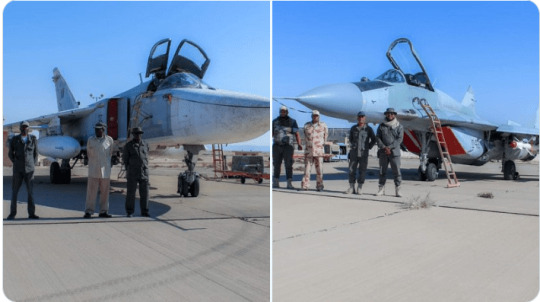
Libyan military replace MiG-29 and Su-24 combat jets in flight
Fernando Valduga By Fernando Valduga 11/03/2022 - 12:17 in Military, War Zones
Aviators from the Libyan National Army (LNA) can now make use of a MiG-29 and a Su-24 Fencer now in airworthiness conditions.
A recent photograph published by the LNA at Jufra Air Base shows a MiG-29 'Fulcrum' fighter armed with air-to-air R-73 and R-27 missiles and a Su-24 attack jet, with the caption stating that they were now flyable.
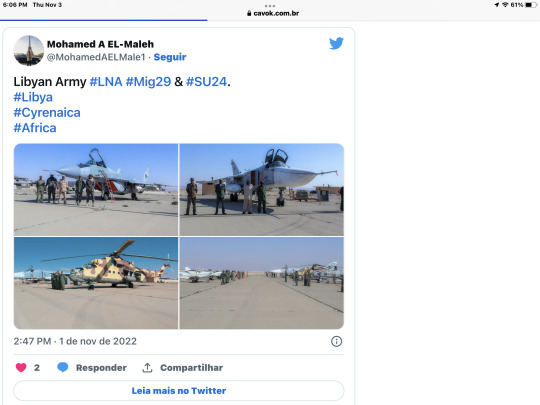
The MiG-29 and Su-24 were delivered to the LNA in May 2020 and are operated by mercenary pilots pending when the LNA pilots complete their training in the types. Fourteen MiG-29 Fulcrum fighters and Sukhoi Su-24 Fencer bombers were delivered by Russia to Libya during the 2019 civil war.
During the delivery, these warplanes were traced from Russia, where they made a stop at the Hamedan air base in eastern Iran, arriving.
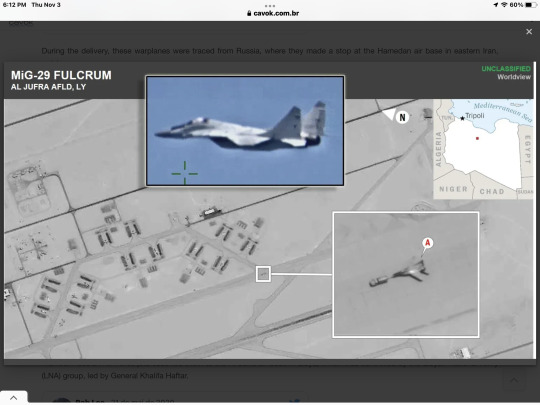
They then flew to the Russian air base of Khmeimim, in western Syria, where social media photos clearly showed that they were not marked. Russian Air Force jets escorted them to the Al-Jufra air base in Libya, which was controlled by the Libyan National Army (LNA) group, led by General Khalifa Haftar.
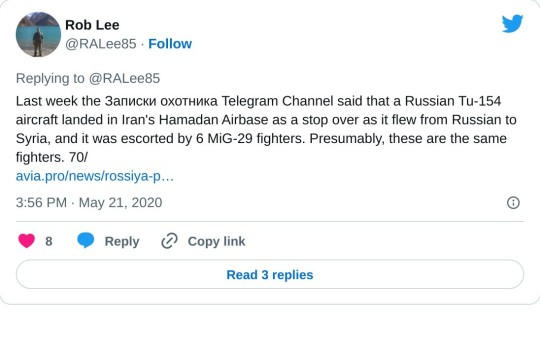
The MiG-29s reached several bases in eastern Libya controlled by the LNA. In June, one of the Libyan-based MiG-29s had overflyed the strategic coastal city of Sirte. The delivery occurred when GNA forces tried to regain control of the area before the opposite sides agreed on a ceasefire in August.

To date, Moscow still officially denies the transfer of these warplanes to Libya, claiming at the same time that the war planes in Al-Jufra in May were restored aircraft of the former Libyan Air Force. However, Colonel Chris Karns, Director of Public Relations of the U.S. African Command (AFRICOM), refutes this statement, stating that "the Libyans never had MiG-29 or Su-24 in their inventory, so anyone who says they 'fixed their old planes' is not representing the facts." (While Libya had Soviet-made Su-24s in the past, it never owned MiG-29s).
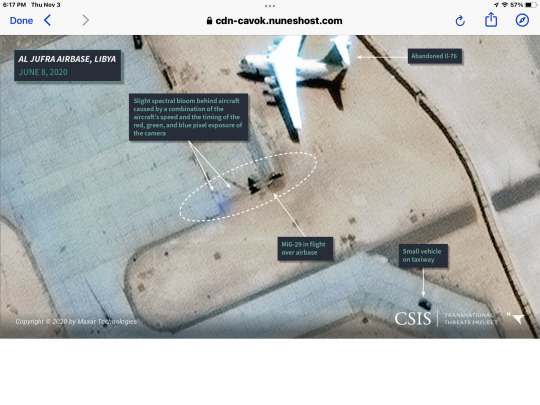

Su-24 and MiG-29 jets seen at Libya Air Base. (Photos: CSIS)
During the conflict, Russian pilots piloted the aircraft, but in an unofficial capacity, especially since the jets were not marked at the time. At the time, some Libyans speculated that the aircraft pilots may belong to the Russian Private Military Contractors (PMCs) ostensibly known as the 'Wagner Group', or possibly former Russian Air Force pilots hired by this group.
“There is concern that these Russian aircraft are being piloted by inexperienced and non-state mercenaries of the PMC who will not adhere to international law; that is, they are not bound by traditional armed conflict laws,” said Bradford Gering, director of operations at AFRICOM.
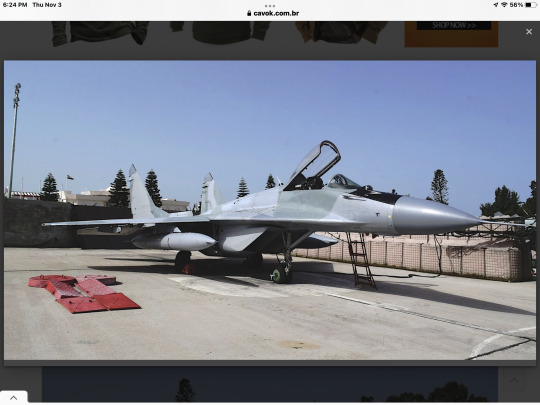

At least two MiG-29 Fulcrum fighters, possibly piloted by the dark Wagner, have fallen in Libya, says Rear Admiral Heidi Berg, intelligence director of the U.S. Africa Command (AFRICOM). One of the MiG-29 was apparently lost on June 28, while the other fell on September 7, 2020. It is not clear if the two MiG-29 were knocked down, suffered a mechanical failure or fell due to a pilot error.
The reactivation of these two jets by Libyan forces follows a pattern intended to sustain their very limited air power capacity. In August 2019, an exclusive Mikoyan-Gurevich MiG-23 Flogger fighter jet was seen at Bnima Benghazi airport, Libya, in service with Khalifa Haftars' Libyan National Army (LNA).

The MiG-23 Flogger, which was previously not operational, became voolable by cannibalizing parts of other affected aircraft. The MiG-23 later dubbed 'Franken-Flogger' by LNA aviators was renovated and made flyable again, attaching two sets of different aircraft wings in a separate central fuselage. However, the much-loved MiG-23ML Flogger fighter/bomber was shot down by the forces of the Government of the National Agreement (GNA) using the MANPADS (Man Portable Air Defense System) five months later.
Similarly, GNA forces made two of Libya's Mirage F-1 fighters fly in June last year. The two Dassault Mirage F-1 fighters (series numbers 502 and 508), along with their brothers, have been effectively grounded since the Tripoli offensive in 2011 due to the lack of spare parts.
Tags: Military AviationLibyan National ArmyMiG-29 FulcrumSu-24 FencerWar Zones - Libya
Previous news
Last AH-1 helicopter delivered marking the beginning of the end of the Huey era
Next news
Hi Fly is back in Antarctica with an Airbus A340
Fernando Valduga
Fernando Valduga
Aviation photographer and pilot since 1992, he has participated in several events and air operations, such as Cruzex, AirVenture, Dayton Airshow and FIDAE. It has works published in specialized aviation magazines in Brazil and abroad. Uses Canon equipment during his photographic work in the world of aviation.
Related news
A KA-1 Woongbi of the Republic of Korea Air Force designated for the 237th Fighter Squadron flies alongside two 25th A-10 Thunderbolt IIs Fighter Squadron. (Photo: ROKAF Senior Master Sgt. Hyung Kwon)
MILITARY
More than 100 USAF aircraft will fly in large-scale exercise with South Korea
03/11/2022 - 18:00
Two F-22 Raptors from Joint Base Elmendorf-Richardson, Alaska, and an F-15E Strike Eagle fly over the area of responsibility of the U.S. Central Command, November 2, 2022. (Photo: US Central Command)
MILITARY
IMAGES: Alaska-based F-22s are deployed on CENTCOM amid Iran's threat
03/11/2022 - 16:00
MILITARY
BAE Systems receives £80 million in Typhoon support contracts
03/11/2022 - 09:00
MILITARY
Russia sends Su-30s in attack against Odessa
02/11/2022 - 16:28
MILITARY
Turkish Navy receives fifth P-72 maritime patrol aircraft
01/11/2022 - 16:00
MILITARY
Ukraine will arm its Bayraktar TB2 with air-to-air missiles to face Russian kamikaze drones
01/11/2022 - 14:00
home Main Page Editorials INFORMATION events Cooperate Specialities advertise about
Cavok Brazil - Digital Tchê Web Creation
Commercial
Executive
Helicopters
HISTORY
Military
Brazilian Air Force
Space
Specialities
Cavok Brazil - Digital Tchê Web Creation
3 notes
·
View notes
Link
By Gloria Verdieu & John Parker
On Oct. 1, the Black Alliance for Peace hosted a webinar titled “AFRICOM at 13: Building the Popular Movement for Demilitarization and Anti-Imperialism in Africa.” The event featured voices rarely heard in the U.S., from countries most affected by AFRICOM, including internationally-known activists for liberation and those representing the growing movement on the continent against U.S. military intervention.
#Africom#BAP#ghana#DRC#Congo#guinea bissau#imperialism#Pentagon#NATO#occupation#antiwar#anti-imperialist#racism#repression#Sudan#Struggle La Lucha
8 notes
·
View notes
Link
The U.S. military has long insisted that it maintains a “light footprint” in Africa, and there have been reports of proposed drawdowns in special operations forces and closures of outposts on the continent, due to a 2017 ambush in Niger and an increasing focus on rivals like China and Russia. But through it all, U.S. Africa Command has fallen short of providing concrete information about its bases on the continent, leaving in question the true scope of the American presence there.
Documents obtained from AFRICOM by The Intercept, via the Freedom of Information Act, however, offer a unique window onto the sprawling network of U.S. military outposts in Africa, including previously undisclosed or unconfirmed sites in hotspots like Libya, Niger, and Somalia. The Pentagon has also told The Intercept that troop reductions in Africa will be modest and phased-in over several years and that no outposts are expected to close as a result of the personnel cuts.
According to a 2018 briefing by AFRICOM science adviser Peter E. Teil, the military’s constellation of bases includes 34 sites scattered across the continent, with high concentrations in the north and west as well as the Horn of Africa. These regions, not surprisingly, have also seen numerous U.S. drone attacks and low-profile commando raids in recent years. For example, Libya — the site of drone and commando missions, but for which President Donald Trump said he saw no U.S. military role just last year — is nonetheless home to three previously undisclosed outposts.
118 notes
·
View notes